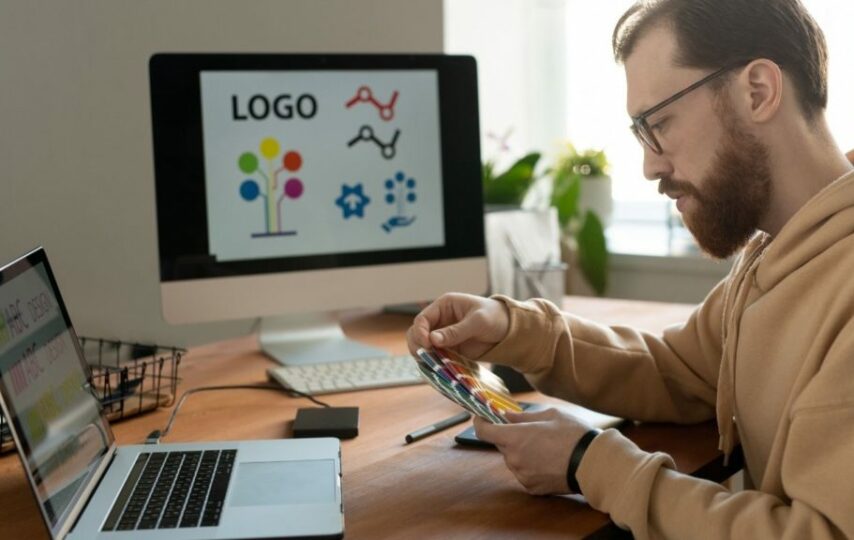In today’s competitive market, a logo is not just a symbol but the face of your brand. It encapsulates your identity, values, and uniqueness. Understanding the art and science behind business logo design is critical for any business aiming to stand out.
This guide provides an in-depth look into creating a logo that not only represents your brand but also resonates with your audience.
What is Business Logo Design?
Business logo design is the process of creating a distinctive and memorable symbol that represents a company’s brand. It’s a visual representation that serves as the cornerstone of your brand identity. An effective logo design communicates your brand’s personality and values, making it an indispensable tool in your marketing arsenal.
Elements of a Successful Logo
A logo is more than just an image; it’s a point of recognition for clients and an important foundation for the branding of your company.
When it comes to business logo design, five key elements stand out as crucial for a successful logo: simplicity, memorability, relevance, timelessness, and versatility.
These elements ensure that your logo not only captures attention but also embodies the essence of your brand.
1. Simplicity
A simple logo design creates instant recognition and a clear brand identity.
Key Idea:
A simple logo design is easily recognizable, making it more likely to stick in the viewer’s mind.
Why It Matters:
Simple designs are easier to remember and recognize, which is crucial for brand recall.
In Practice:
Focus on a single element that captures your brand’s essence without overcomplicating the design.
2. Memorability
An unforgettable logo leaves a lasting impression, ensuring brand recall.
Key Idea:
Memorable logos stay with the audience after just one glance.
Why It Matters:
A logo that stands out in a customer’s mind creates a lasting impression, enhancing brand recall.
In Practice:
Unique but straightforward designs that create an emotional connection with the audience are more likely to be remembered.
3. Relevance
Ensure your logo resonates with your audience and industry for meaningful engagement.
Key Idea:
Your logo should be relevant to your industry, your brand values, and your target audience.
Why It Matters:
Relevance ensures that your logo resonates with your intended audience and accurately represents your brand.
In Practice:
Tailor your logo’s imagery, color, and font to align with what your brand stands for and whom it serves.
4. Timelessness
Key Idea:
A timeless logo remains effective and relevant over many years.
Why It Matters:
Timeless designs avoid frequent rebranding due to outdated looks.
In Practice:
Focus on enduring design elements over trendy ones to ensure longevity.
5. Versatility
Key Idea:
A versatile logo works across various mediums and applications.
Why It Matters:
Versatility allows your logo to be functional and recognizable, whether it’s on a business card, website, or billboard.
In Practice:
Test your logo in different sizes and on various platforms to ensure it maintains its integrity and effectiveness.
The Logo Design Process
The logo design process is a meticulous journey from understanding a brand’s essence to crafting a visually compelling and relevant logo that resonates with its target audience, reflecting careful consideration at every stage to balance creativity with practicality.
All the process steps below are aimed at creating a logo that not only captures the brand’s identity but also stands out in the competitive marketplace, ensuring the investment in business logo design translates into long-term value.
1. Understanding the Brand
Align logo design with the brand’s core values, target audience, and industry specifics.
- Brand Analysis: This involves a thorough review of the brand’s mission, vision, and values. It’s crucial to understand the essence of the brand to ensure the logo accurately reflects its ethos.
- Target Audience Profiling: Identify the demographics (age, gender, location), psychographics (interests, lifestyle, values), and preferences of the target market. This step is vital to ensure the logo appeals to the intended audience.
- Industry Evaluation: Analyze current trends, customer expectations, and competitor branding within the industry. This research helps in creating a logo that is not only unique but also relevant and resonant within the market space.
2. Research and Brainstorming
Collect ideas and inspirations that resonate with the brand’s identity.
- Idea Generation: Conduct brainstorming sessions with designers, stakeholders, and sometimes customers to generate a wide array of concepts. This collaborative approach encourages diverse perspectives and innovative ideas.
- Mood Boards: Create visual collages or collections that represent various aspects of the brand’s desired aesthetic and emotional appeal. Mood boards can include colors, imagery, typography, and other design elements that convey the brand’s spirit.
- Concept Validation: Review the generated ideas against the brand strategy and audience expectations to ensure they align well. This step filters out concepts that do not effectively represent the brand’s identity.
3. Sketching and Conceptualization
Translate brainstormed ideas into tangible visual concepts.
- Hand Sketching: Begin with hand-drawn sketches to draft multiple logo concepts quickly. This phase is about exploring creativity without the constraints of digital tools.
- Concept Refinement: Select the most promising sketches and refine them, focusing on clarity, impact, and alignment with the brand’s identity.
- Feedback Integration: Early feedback from stakeholders or potential users is integrated at this stage to improve and evolve the concepts before they are digitized.
4. Digital Implementation
Transform hand-drawn sketches into polished digital designs.
- Digital Drafting: Use design software, such as Adobe Illustrator, to create clean, scalable digital versions of the refined sketches.
- Color and Typography Selection: Choose colors and fonts that complement and enhance the brand’s personality. This step involves understanding color psychology and typography’s impact on brand perception.
- Layout Adjustments: Experiment with different layouts, scaling, and compositions to ensure the logo is versatile and effective across various mediums and applications.
5. Feedback and Revisions
Refine the logo design based on comprehensive feedback.
- Client Presentation: Present the digital logo concepts to the client, accompanied by explanations of how each design aligns with the brand’s objectives.
- Iterative Revisions: Revise the designs based on client feedback, industry standards, and best practices. This iterative process ensures the final logo is polished, effective, and satisfying to the client.
- Final Approval: The design is finalized after multiple rounds of revisions, resulting in a logo that meets the client’s satisfaction and effectively represents the brand.
Selecting a skilled designer or agency is crucial. Consider their experience, understanding of your business, and communication style. For expert business logo design services, visit our service page.
Understanding Logo Design Cost
The cost of designing a logo is a topic of significant interest for businesses looking to create or revamp their visual identity. Understanding the factors that influence logo design cost is crucial for making informed decisions and ensuring that the investment aligns with the expected value. Below are the Factors Influencing Logo Design Costs:
- Complexity of Design:
Simple logos with minimalistic designs generally cost less than complex ones. Detailed designs involving intricate graphics or custom illustrations require more time and skill, thus increasing the cost.
- Designer or Agency Expertise:
Experienced designers or well-established agencies typically charge more, reflecting their expertise and track record. The cost can vary significantly based on the designer’s reputation, awards, or recognition in the field of business logo design.
- Project Requirements:
Specific requirements such as the number of revisions, the urgency of the project, and the range of applications (e.g., digital, print, merchandise) can impact the cost. Additional services like brand identity development, marketing materials, or style guides also contribute to the overall cost.
- Market Research and Brand Strategy Involvement:
Incorporating comprehensive market research and brand strategy into the design process can elevate the cost but contribute to creating a more effective and targeted logo.
- Rights and Ownership:
The cost may include obtaining full rights and ownership of the final logo design, which is crucial for exclusive use by the company.
Pricing Models in Logo Design
- Fixed Rate: A one-time fee covering the entire logo design process, suitable for clearly defined projects.
- Hourly Rate: Payment based on the time spent by the designer, preferred for projects where the scope is not well-defined.
- Package Deals: Bundled services offering logo design along with other branding materials, often at a discounted rate compared to individual services.
Return on Investment (ROI) in Logo Design
Investing in professional logo design can have a significant impact on brand recognition and customer perception. A well-designed logo enhances brand identity, contributes to customer trust, and can lead to increased business.
Understanding logo design cost is a crucial aspect of the branding process. It’s not just about finding the most affordable option but about investing in a logo that effectively represents your brand and resonates with your audience.
For businesses seeking top-quality business logo design, considering these factors will guide you in making an informed decision. To explore detailed pricing options, visit our logo design pricing page.
Do’s and Don’ts in Logo Design
Creating a logo that stands the test of time while effectively conveying a brand’s message is an art. Understanding the dos and don’ts is crucial for designers and businesses alike, as it directly influences the logo design cost and overall brand perception.
Here’s a detailed guide:
Do’s in Logo Design
- Keep It Simple:
Simplicity ensures that your logo is easily recognizable and memorable. Focus on minimalistic designs that convey your message without unnecessary complexity.
- Make It Memorable:
A memorable logo helps in building brand recognition. Use unique shapes or symbols that stick in the viewer’s mind.
- Ensure Relevance:
The logo must resonate with your brand’s industry, values, and target audience. Tailor your design to reflect your brand’s personality and the expectations of your target audience.
- Ensure Versatility and Scalability:
Your logo should be functional across various mediums and sizes. Design with multiple applications in mind, ensuring it looks good on everything from a business card to a billboard.
- Be Timeless:
A timeless design ensures your logo doesn’t become outdated quickly. Avoid trendy designs that may not age well and focus on a classic aesthetic.
Don’ts in Logo Design
- Avoid Overcomplicating the Design:
Too many elements can make your logo confusing and hard to reproduce. Limit the number of colors, fonts, and shapes to maintain clarity.
- Don’t Neglect Color Psychology and Typography:
Colors and fonts play a crucial role in conveying your brand’s message and emotional appeal. Choose colors and fonts that align with the emotions and values your brand represents.
- Avoid Being Too Literal:
Overly literal logos can lack creativity and fail to stand out. Use abstract or symbolic elements to represent your brand in a more nuanced way.
- Don’t Copy Trends Blindly:
Following trends can make your logo look like many others and become quickly outdated. Strive for a unique design that reflects your brand’s identity rather than current fads.
- Avoid Neglecting Feedback:
Feedback is essential for understanding how your logo is perceived by others. Seek opinions from varied audiences and be open to constructive criticism.
Wrapping it Up
Your business logo is more than just a graphic; it’s the symbol of your brand’s identity. Investing in professional business logo design and understanding the nuances of logo design cost are essential steps toward building a strong brand presence. Embrace the power of a well-designed logo to tell your brand’s story.
RevvLab – Creating Logos That Resonate
As RevvLab, we pride ourselves on being more than just a software development company. We are innovators and creators at heart, dedicated to transforming businesses with powerful, scalable technology solutions.
Our expertise lies in understanding the unique needs of each client and crafting bespoke solutions that not only meet the demands of the present but also open up a world of future possibilities.
Whether it’s through our cutting-edge custom software, intuitive UI/UX designs, or our strategic SEO services, we are committed to maximizing your digital impact.
Let RevvLab be the driving force behind your next digital venture, where your vision meets our technological prowess to create something truly remarkable.








